


Christmas Store
The holidays are just around the corner so now is the time to fetch the finest gifts for the Labrador Lover on your Christmas list. We have over 100 gifts $50.00 and under. Visit our Christmas Store.
For the Lab
Bedding
Coats
Collars and Leads
Dog Bowls
Feeding Stations
Spa and Grooming
Toys and Treats
Travel and Accessories
For the Lab Lover
Apparel
Cards and Giftwrap
Fine Accessories
Gifts and All Occasions
Jewelry
Kids Only
For the Lab Home
Artwork
Books
Garden and Outdoor
Home Furnishings
Kitchen Accessories
Pillows, Throws, and Rugs
Gift ServicesGift Boxes
Gift Certificates
From Rescued to RescueR
By Ellen English
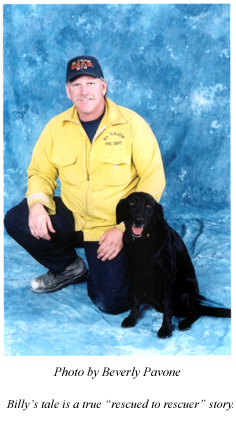 “The type of dog who typically drives people nuts can make a great search dog,” Mike Scott explains. The veteran Rescue Specialist from the El Cajon Fire Dept in San Diego, California recalls how he came to be paired with his canine partner, Billy, as a Disaster Search team: “A person from the San Bernadino area called the National Disaster Search Dog Foundation (NDSDF) to say they had a black Lab they couldn’t handle anymore who might be a potential search dog.” About a year old at the time, Billy was evaluated by the Foundation and deemed to be a viable candidate for their unique training program which takes rescued dogs and turns them into rescuers.
“The type of dog who typically drives people nuts can make a great search dog,” Mike Scott explains. The veteran Rescue Specialist from the El Cajon Fire Dept in San Diego, California recalls how he came to be paired with his canine partner, Billy, as a Disaster Search team: “A person from the San Bernadino area called the National Disaster Search Dog Foundation (NDSDF) to say they had a black Lab they couldn’t handle anymore who might be a potential search dog.” About a year old at the time, Billy was evaluated by the Foundation and deemed to be a viable candidate for their unique training program which takes rescued dogs and turns them into rescuers.
Before beginning his official search training at Sundowners Kennels, the energetic black Lab moved to what the Foundation calls a “Canine Prep Home,” for obedience training and socialization. In Billy’s case, this happened to be with NDSDF founder Wilma Melville. As Wilma recalls, “Billy was ‘driven’ alright but I wondered about his ability to focus. He seemed so scattered and would run wily-nily around the pool area until his feet would be sore. The guy was quite a challenge to manage and I was learning how to do that first. The thing that finally had me send Billy to Sundowners was this....Billy was outside the wrought iron fence and John threw a toy over the fence and into the pool. Billy went THROUGH the vertical wrought iron fence into the pool to retrieve that toy. Yes, Billy yelped as he shoved himself through, but through he went and he was one happy critter because he had the toy. Billy simply HAD to have a toy. If there was not a toy available, Billy would find one....be it a bush, a rock, a plant....you name it, it became a toy if there was nothing else.”
Sundowners Kennels, located in Gilroy, California, is owned and managed by Pluis Davern, a professional dog and handler trainer with 35 years of experience. Under Pluis’ expert direction, Billy received six months of intensive training that included advanced obedience and disaster search skills. These skills included verbal and non-verbal (hand) direction control, searching on rubble piles and other uneven and continually shifting surfaces, climbing a ladder, ignoring all scents other than live human scent, and alerting a handler when a survivor is located. As Mike explains, “Billy is only trained for live scent. The Foundation feels strongly that to add cadaver (detection) to a dog (trained for live scent) results in a dog that is not as effective.” Billy’s exuberance was now focused on a specific task: finding people. “The training at Sundowners was the best thing for Billy,” Wilma Melville continues, “he developed some self control, maturity and above all....a job.”
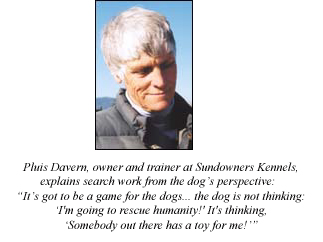 Billy’s reward for this job well done is a very special toy. Search & Rescue dogs, like most working dogs, are trained to work for a particular reward, but Disaster dogs require one that is something other than what they might come across in a disaster situation. “We don’t use tennis balls, Frisbees or food for instance because, if you think about it, these are all things that a dog might come upon in a collapsed building and we don’t want them to be able to self-reward,” Mike explains. Billy’s search toy is specially made from a section of fire hose (how appropriate) that is stuffed and fitted with a handle. “It’s great for playing tug and it’s also easy to stuff into crevices for training sessions....plus, it’s something he’s highly unlikely to run across during a search.”
Billy’s reward for this job well done is a very special toy. Search & Rescue dogs, like most working dogs, are trained to work for a particular reward, but Disaster dogs require one that is something other than what they might come across in a disaster situation. “We don’t use tennis balls, Frisbees or food for instance because, if you think about it, these are all things that a dog might come upon in a collapsed building and we don’t want them to be able to self-reward,” Mike explains. Billy’s search toy is specially made from a section of fire hose (how appropriate) that is stuffed and fitted with a handle. “It’s great for playing tug and it’s also easy to stuff into crevices for training sessions....plus, it’s something he’s highly unlikely to run across during a search.”
Even though Mike Scott had been with the El Cajon Dept for many years (now 18 years) including 10 years with the FEMA Urban Search & Rescue Task Force, he had never worked with or trained a dog professionally. He’d seen Rescue dogs at the Atlanta Olympics but it wasn’t until a friend, another firefighter, got a chocolate Lab from the NDSDF that Mike became intrigued by their working relationship. He made a request to the Foundation to receive a dog and was eventually sent to Sundowners to undergo an intensive five-day training course with experienced Search dogs.
Once both handler and dog completed their preliminary training, Pluis matched them up based on temperament and learning styles. As Mike remembers, “there were 3 or 4 dogs graduating at the same time and you didn’t know who you’d be paired with. She basically sizes people up and says ‘this dog will suit your personality.’ Pluis does a remarkable job...she has a way of seeing who will fit together. Billy is in some respects a softer, more even tempered dog and I’m somewhat easy going.” The new team trained at Sundowners for five more days, practicing together the skills they had worked on separately. “It was a pretty bumpy road at the beginning,” Mike recalls, “the dogs really had to train us!”
Mike then got to take Billy home with him, to continue the bonding process and their training, which was far from over. “It takes about a year together as a team before you’re ready to take the FEMA test,” Mike continues, “it’s a huge commitment... the travel time, the logistics of setting up disaster type practice settings, it’s a lot more involved than most people realize.” Billy went to work with Mike for his 24 hour shifts, where the Lab was initially restricted to a roomy 6 x 10 foot kennel except for regular breaks and training sessions. “Restricting his free time, especially at the beginning, helped keep him focused until he really understood what his job was. Actually, these dogs probably get more interaction and play time than most pets...it’s just that we make them earn their play time,” Mike explains.
The team worked diligently with their local training group to prepare for the two-step process of becoming certified through FEMA. The first, basic test involved agility, obedience, directionals, a focused bark alert (where the dog indicates to the handler that he’s made a find) and a simple search. The second test took place several months later and is “arguably the hardest test of canine behavior,” Mike says, “the dog has to search 3 sites of up to 15,000 square feet that include a total of 6 hidden victims. They set up distractions to test the dog, like food or even a live cat or rabbit in a cage. You have to send the dog to search independently, sometimes out of site. It takes approximately 3 hours for one team to complete the advanced test and the failure rate is pretty high.”
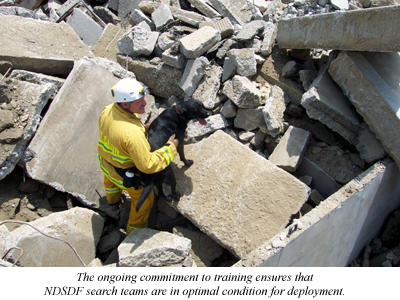 Even after passing the advanced test in 1999, their training continued, and does to this day. Regular sessions, now twice a week, with other teams in their area are a must, plus "tune-ups" at Sundowners to sharpen their skills and address any deficiencies. Mike and Billy must also pass a re-certification test every two years. In fact, the dedicated team just completed their third re-certification in December.
Even after passing the advanced test in 1999, their training continued, and does to this day. Regular sessions, now twice a week, with other teams in their area are a must, plus "tune-ups" at Sundowners to sharpen their skills and address any deficiencies. Mike and Billy must also pass a re-certification test every two years. In fact, the dedicated team just completed their third re-certification in December.
Billy’s biggest and certainly most high profile assignment to date was working at the World Trade Center after the September 11th terrorist attacks. The team was in New York for 10 days, actually working on-site about 7 of those. “We were scheduled for 12 hour shifts,” Mike recalls, “but in reality they were 16 to 17 hour days because of the briefings, travel time and other logistics. There was steel everywhere and lots of sharp objects...really rough terrain, so we had to let the dogs negotiate it on their own and search independently...the terrain really slowed them down but fortunately the dogs had no serious injuries.” As the world soon came to know, the magnitude of the event was such that the vast majority of the victims were totally disintegrated. “The level of destruction was pretty complete,” Mike explains, “and after you’ve sent your dog 5 or 6 times to search with no success, they start to get de-motivated, giving you that look that says ‘this is no fun.’ We set up (mock) searches in nearby buildings, hiding firemen and other rescue workers to help re-motivate the dogs.”
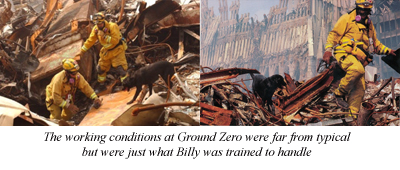 Their most recent task was searching an area where a retaining wall had given way, causing a bluff to completely collapse. “They sent us in to make sure no one had gotten trapped.” The type of work Billy does, however, is so specialized that he doesn’t get a lot of chances to work. “A Disaster Dog may only have one actual scenario in their entire career,” Mike explains. Consequently, Mike and his friend Steve presented a unique concept to the Foundation that became the NDSDF’s annual Irondog Competition. “It’s a way to challenge these highly trained dogs and expose them to unusual conditions. It tests how well the dogs work when their routine is disrupted.” It’s also a fun way to encourage trainers to keep specific skill levels high, since each of the 6 areas of competition incorporate critical Search & Rescue techniques that get timed and scored: hasty search, mapping, send out and recall, emergency stop, direction control and even a medley race.
Their most recent task was searching an area where a retaining wall had given way, causing a bluff to completely collapse. “They sent us in to make sure no one had gotten trapped.” The type of work Billy does, however, is so specialized that he doesn’t get a lot of chances to work. “A Disaster Dog may only have one actual scenario in their entire career,” Mike explains. Consequently, Mike and his friend Steve presented a unique concept to the Foundation that became the NDSDF’s annual Irondog Competition. “It’s a way to challenge these highly trained dogs and expose them to unusual conditions. It tests how well the dogs work when their routine is disrupted.” It’s also a fun way to encourage trainers to keep specific skill levels high, since each of the 6 areas of competition incorporate critical Search & Rescue techniques that get timed and scored: hasty search, mapping, send out and recall, emergency stop, direction control and even a medley race.
Billy has also participated in “dozens” of school and community events where they demonstrate agility skills and some basic search concepts. “We’ll hide one kid in a classroom full of students, and he’ll work to find the one that’s hidden-ignoring all the ones sitting out in plain site. The kids love it,” Mike explains.
Now that he’s a veteran Search dog who knows his job well, Billy enjoys a bit more relaxed routine. He has access to a patio enclosure at the station where the dogs hang out, and at home, he enjoys a big back yard, a swimming pool and some family time. Like most Labs, “Billy craves human interaction...he would sit in your lap if he could,” Mike laughs, “my wife calls him a ‘lover dog.’” After all, his personality is a large part of how he got this job. As Mike says, “80% of the Foundation’s dogs are Labs...they have a great prey drive and they love to have fun. If Billy could just talk and drive, he wouldn’t need me!”
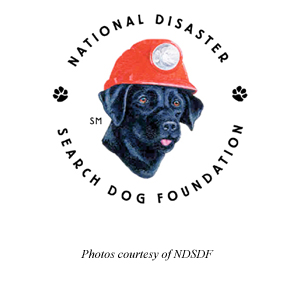 National Disaster Search Dog Foundation
National Disaster Search Dog Foundation
Janet Reineck, Director of Development for the Search Dog Foundation, explains more about their program: “The SDF recruits dogs rescued from abuse or abandonment, gives them professional training, and partners them with firefighters to find people buried alive in the wreckage of natural disasters or terrorist attacks. We ensure lifetime care for each dog: once rescued, these dogs will never need to be rescued again. As a not-for-profit that receives no government funding, SDF relies on the generosity of its supporters to provide canine search teams at no cost to fire departments and other service agencies. We are a small organization doing big things for America, thanks to thousands of hours donated by firefighters and volunteers throughout the nation.”
The only organization of its kind in the country, the NDSDF was founded in 1996 by retired schoolteacher, Wilma Melville, after she and her dog Murphy were deployed to the Oklahoma City bombing site. After the September 11th attack on the World Trade Center, 33 percent of the canine/handler search teams sent to Ground Zero were from NDSDF. Four recent graduates have been chosen to serve with the Capitol Police Department team charged with protecting Congress and the White House.
It costs the Foundation $10,000 to rescue and train a dog. No other organization in the country underwrites this expense, providing search dogs to fire departments at no cost. The NDSDF doesn’t have a large fundraising department, relying instead on the generosity of individuals who care about having these teams available for the next major disaster. The person they rescue may be someone you love…or you.
Be part of the search!™ by making a donation. For information on how your contribution will help the Foundation rescue dogs and save lives, we invite you to visit the National Disaster Search Dog Foundation online.
Click here to go back to Lab of the Month
By Ellen English
 “The type of dog who typically drives people nuts can make a great search dog,” Mike Scott explains. The veteran Rescue Specialist from the El Cajon Fire Dept in San Diego, California recalls how he came to be paired with his canine partner, Billy, as a Disaster Search team: “A person from the San Bernadino area called the National Disaster Search Dog Foundation (NDSDF) to say they had a black Lab they couldn’t handle anymore who might be a potential search dog.” About a year old at the time, Billy was evaluated by the Foundation and deemed to be a viable candidate for their unique training program which takes rescued dogs and turns them into rescuers.
“The type of dog who typically drives people nuts can make a great search dog,” Mike Scott explains. The veteran Rescue Specialist from the El Cajon Fire Dept in San Diego, California recalls how he came to be paired with his canine partner, Billy, as a Disaster Search team: “A person from the San Bernadino area called the National Disaster Search Dog Foundation (NDSDF) to say they had a black Lab they couldn’t handle anymore who might be a potential search dog.” About a year old at the time, Billy was evaluated by the Foundation and deemed to be a viable candidate for their unique training program which takes rescued dogs and turns them into rescuers.Before beginning his official search training at Sundowners Kennels, the energetic black Lab moved to what the Foundation calls a “Canine Prep Home,” for obedience training and socialization. In Billy’s case, this happened to be with NDSDF founder Wilma Melville. As Wilma recalls, “Billy was ‘driven’ alright but I wondered about his ability to focus. He seemed so scattered and would run wily-nily around the pool area until his feet would be sore. The guy was quite a challenge to manage and I was learning how to do that first. The thing that finally had me send Billy to Sundowners was this....Billy was outside the wrought iron fence and John threw a toy over the fence and into the pool. Billy went THROUGH the vertical wrought iron fence into the pool to retrieve that toy. Yes, Billy yelped as he shoved himself through, but through he went and he was one happy critter because he had the toy. Billy simply HAD to have a toy. If there was not a toy available, Billy would find one....be it a bush, a rock, a plant....you name it, it became a toy if there was nothing else.”
Sundowners Kennels, located in Gilroy, California, is owned and managed by Pluis Davern, a professional dog and handler trainer with 35 years of experience. Under Pluis’ expert direction, Billy received six months of intensive training that included advanced obedience and disaster search skills. These skills included verbal and non-verbal (hand) direction control, searching on rubble piles and other uneven and continually shifting surfaces, climbing a ladder, ignoring all scents other than live human scent, and alerting a handler when a survivor is located. As Mike explains, “Billy is only trained for live scent. The Foundation feels strongly that to add cadaver (detection) to a dog (trained for live scent) results in a dog that is not as effective.” Billy’s exuberance was now focused on a specific task: finding people. “The training at Sundowners was the best thing for Billy,” Wilma Melville continues, “he developed some self control, maturity and above all....a job.”
 Billy’s reward for this job well done is a very special toy. Search & Rescue dogs, like most working dogs, are trained to work for a particular reward, but Disaster dogs require one that is something other than what they might come across in a disaster situation. “We don’t use tennis balls, Frisbees or food for instance because, if you think about it, these are all things that a dog might come upon in a collapsed building and we don’t want them to be able to self-reward,” Mike explains. Billy’s search toy is specially made from a section of fire hose (how appropriate) that is stuffed and fitted with a handle. “It’s great for playing tug and it’s also easy to stuff into crevices for training sessions....plus, it’s something he’s highly unlikely to run across during a search.”
Billy’s reward for this job well done is a very special toy. Search & Rescue dogs, like most working dogs, are trained to work for a particular reward, but Disaster dogs require one that is something other than what they might come across in a disaster situation. “We don’t use tennis balls, Frisbees or food for instance because, if you think about it, these are all things that a dog might come upon in a collapsed building and we don’t want them to be able to self-reward,” Mike explains. Billy’s search toy is specially made from a section of fire hose (how appropriate) that is stuffed and fitted with a handle. “It’s great for playing tug and it’s also easy to stuff into crevices for training sessions....plus, it’s something he’s highly unlikely to run across during a search.”Even though Mike Scott had been with the El Cajon Dept for many years (now 18 years) including 10 years with the FEMA Urban Search & Rescue Task Force, he had never worked with or trained a dog professionally. He’d seen Rescue dogs at the Atlanta Olympics but it wasn’t until a friend, another firefighter, got a chocolate Lab from the NDSDF that Mike became intrigued by their working relationship. He made a request to the Foundation to receive a dog and was eventually sent to Sundowners to undergo an intensive five-day training course with experienced Search dogs.
Once both handler and dog completed their preliminary training, Pluis matched them up based on temperament and learning styles. As Mike remembers, “there were 3 or 4 dogs graduating at the same time and you didn’t know who you’d be paired with. She basically sizes people up and says ‘this dog will suit your personality.’ Pluis does a remarkable job...she has a way of seeing who will fit together. Billy is in some respects a softer, more even tempered dog and I’m somewhat easy going.” The new team trained at Sundowners for five more days, practicing together the skills they had worked on separately. “It was a pretty bumpy road at the beginning,” Mike recalls, “the dogs really had to train us!”
Mike then got to take Billy home with him, to continue the bonding process and their training, which was far from over. “It takes about a year together as a team before you’re ready to take the FEMA test,” Mike continues, “it’s a huge commitment... the travel time, the logistics of setting up disaster type practice settings, it’s a lot more involved than most people realize.” Billy went to work with Mike for his 24 hour shifts, where the Lab was initially restricted to a roomy 6 x 10 foot kennel except for regular breaks and training sessions. “Restricting his free time, especially at the beginning, helped keep him focused until he really understood what his job was. Actually, these dogs probably get more interaction and play time than most pets...it’s just that we make them earn their play time,” Mike explains.
The team worked diligently with their local training group to prepare for the two-step process of becoming certified through FEMA. The first, basic test involved agility, obedience, directionals, a focused bark alert (where the dog indicates to the handler that he’s made a find) and a simple search. The second test took place several months later and is “arguably the hardest test of canine behavior,” Mike says, “the dog has to search 3 sites of up to 15,000 square feet that include a total of 6 hidden victims. They set up distractions to test the dog, like food or even a live cat or rabbit in a cage. You have to send the dog to search independently, sometimes out of site. It takes approximately 3 hours for one team to complete the advanced test and the failure rate is pretty high.”
 Even after passing the advanced test in 1999, their training continued, and does to this day. Regular sessions, now twice a week, with other teams in their area are a must, plus "tune-ups" at Sundowners to sharpen their skills and address any deficiencies. Mike and Billy must also pass a re-certification test every two years. In fact, the dedicated team just completed their third re-certification in December.
Even after passing the advanced test in 1999, their training continued, and does to this day. Regular sessions, now twice a week, with other teams in their area are a must, plus "tune-ups" at Sundowners to sharpen their skills and address any deficiencies. Mike and Billy must also pass a re-certification test every two years. In fact, the dedicated team just completed their third re-certification in December.Billy’s biggest and certainly most high profile assignment to date was working at the World Trade Center after the September 11th terrorist attacks. The team was in New York for 10 days, actually working on-site about 7 of those. “We were scheduled for 12 hour shifts,” Mike recalls, “but in reality they were 16 to 17 hour days because of the briefings, travel time and other logistics. There was steel everywhere and lots of sharp objects...really rough terrain, so we had to let the dogs negotiate it on their own and search independently...the terrain really slowed them down but fortunately the dogs had no serious injuries.” As the world soon came to know, the magnitude of the event was such that the vast majority of the victims were totally disintegrated. “The level of destruction was pretty complete,” Mike explains, “and after you’ve sent your dog 5 or 6 times to search with no success, they start to get de-motivated, giving you that look that says ‘this is no fun.’ We set up (mock) searches in nearby buildings, hiding firemen and other rescue workers to help re-motivate the dogs.”
 Their most recent task was searching an area where a retaining wall had given way, causing a bluff to completely collapse. “They sent us in to make sure no one had gotten trapped.” The type of work Billy does, however, is so specialized that he doesn’t get a lot of chances to work. “A Disaster Dog may only have one actual scenario in their entire career,” Mike explains. Consequently, Mike and his friend Steve presented a unique concept to the Foundation that became the NDSDF’s annual Irondog Competition. “It’s a way to challenge these highly trained dogs and expose them to unusual conditions. It tests how well the dogs work when their routine is disrupted.” It’s also a fun way to encourage trainers to keep specific skill levels high, since each of the 6 areas of competition incorporate critical Search & Rescue techniques that get timed and scored: hasty search, mapping, send out and recall, emergency stop, direction control and even a medley race.
Their most recent task was searching an area where a retaining wall had given way, causing a bluff to completely collapse. “They sent us in to make sure no one had gotten trapped.” The type of work Billy does, however, is so specialized that he doesn’t get a lot of chances to work. “A Disaster Dog may only have one actual scenario in their entire career,” Mike explains. Consequently, Mike and his friend Steve presented a unique concept to the Foundation that became the NDSDF’s annual Irondog Competition. “It’s a way to challenge these highly trained dogs and expose them to unusual conditions. It tests how well the dogs work when their routine is disrupted.” It’s also a fun way to encourage trainers to keep specific skill levels high, since each of the 6 areas of competition incorporate critical Search & Rescue techniques that get timed and scored: hasty search, mapping, send out and recall, emergency stop, direction control and even a medley race.Billy has also participated in “dozens” of school and community events where they demonstrate agility skills and some basic search concepts. “We’ll hide one kid in a classroom full of students, and he’ll work to find the one that’s hidden-ignoring all the ones sitting out in plain site. The kids love it,” Mike explains.
Now that he’s a veteran Search dog who knows his job well, Billy enjoys a bit more relaxed routine. He has access to a patio enclosure at the station where the dogs hang out, and at home, he enjoys a big back yard, a swimming pool and some family time. Like most Labs, “Billy craves human interaction...he would sit in your lap if he could,” Mike laughs, “my wife calls him a ‘lover dog.’” After all, his personality is a large part of how he got this job. As Mike says, “80% of the Foundation’s dogs are Labs...they have a great prey drive and they love to have fun. If Billy could just talk and drive, he wouldn’t need me!”
 National Disaster Search Dog Foundation
National Disaster Search Dog FoundationJanet Reineck, Director of Development for the Search Dog Foundation, explains more about their program: “The SDF recruits dogs rescued from abuse or abandonment, gives them professional training, and partners them with firefighters to find people buried alive in the wreckage of natural disasters or terrorist attacks. We ensure lifetime care for each dog: once rescued, these dogs will never need to be rescued again. As a not-for-profit that receives no government funding, SDF relies on the generosity of its supporters to provide canine search teams at no cost to fire departments and other service agencies. We are a small organization doing big things for America, thanks to thousands of hours donated by firefighters and volunteers throughout the nation.”
The only organization of its kind in the country, the NDSDF was founded in 1996 by retired schoolteacher, Wilma Melville, after she and her dog Murphy were deployed to the Oklahoma City bombing site. After the September 11th attack on the World Trade Center, 33 percent of the canine/handler search teams sent to Ground Zero were from NDSDF. Four recent graduates have been chosen to serve with the Capitol Police Department team charged with protecting Congress and the White House.
It costs the Foundation $10,000 to rescue and train a dog. No other organization in the country underwrites this expense, providing search dogs to fire departments at no cost. The NDSDF doesn’t have a large fundraising department, relying instead on the generosity of individuals who care about having these teams available for the next major disaster. The person they rescue may be someone you love…or you.
Be part of the search!™ by making a donation. For information on how your contribution will help the Foundation rescue dogs and save lives, we invite you to visit the National Disaster Search Dog Foundation online.
Click here to go back to Lab of the Month
Featured Article
 Can You Spot The Holiday Hazards?
Can You Spot The Holiday Hazards?
It’s easy for pets, especially Labradors, to get into trouble during the holidays. You may get so busy that you lose track of what is going on with your dog.
Click here to learn more about: "Can You Spot The Holiday Hazards?"
 Can You Spot The Holiday Hazards?
Can You Spot The Holiday Hazards?It’s easy for pets, especially Labradors, to get into trouble during the holidays. You may get so busy that you lose track of what is going on with your dog.
Click here to learn more about: "Can You Spot The Holiday Hazards?"
Wanted: Models

Would you like to see your Lab pictured here? Send us images of your Lab and we may include them on our Home Page!

Would you like to see your Lab pictured here? Send us images of your Lab and we may include them on our Home Page!
Labrador Library
Labrador Links
The Verstaile Lab
History of the Lab
Advice
Travel
Featured Labs
Featured Artists
Labrador Links
The Verstaile Lab
History of the Lab
Advice
Travel
Featured Labs
Featured Artists
.jpg)

